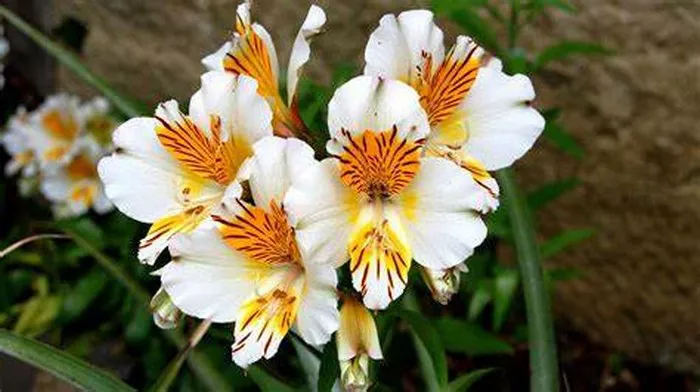Alstroemeria, often referred to as the Peruvian Lily or Lily of the Incas, is a genus of flowering plants native to South America. Renowned for its vibrant colors and delicate petals, Alstroemeria has captured the hearts of gardeners and flower enthusiasts worldwide. In this comprehensive guide, we delve into the anatomy, variations, significance, and cultivation of Alstroemeria flowers, shedding light on their allure and appeal.
Anatomy of Alstroemeria Flowers
Alstroemeria flowers boast a distinctive anatomy characterized by intricate details and structural elegance. Each blossom typically consists of six tepals, which are modified petals and sepals that resemble each other. These tepals showcase a spectrum of hues ranging from soft pastels to rich, saturated tones, making Alstroemeria a visual delight.
At the center of the flower, the stamens and pistil stand prominently. The stamens, male reproductive organs, produce pollen grains crucial for fertilization. Surrounding the stamens is the pistil, the female reproductive organ comprising the stigma, style, and ovary. Pollination occurs when pollen from the stamens is transferred to the stigma, facilitating the formation of seeds within the ovary.
The foliage of Alstroemeria plants is equally captivating, with slender, lance-shaped leaves arranged in a spiral pattern along the stems. These glossy green leaves serve not only as a backdrop for the resplendent blooms but also contribute to the plant’s overall aesthetic appeal.
Variations in Alstroemeria Flowers
One of the most captivating aspects of Alstroemeria flowers is their remarkable diversity in color and pattern. From solid hues to intricate markings, there exists a plethora of variations within the genus, offering something to suit every preference and garden aesthetic.
Common color variations include shades of pink, red, orange, yellow, purple, and white. Some cultivars feature bi-colored or tri-colored blooms, adding depth and visual interest to floral arrangements. Additionally, certain varieties exhibit distinctive patterns such as speckles, stripes, or flecks, further enhancing the allure of Alstroemeria flowers.
Beyond color and pattern, Alstroemeria cultivars also vary in size and form. While some produce petite, dainty blooms ideal for delicate arrangements, others boast larger, showier flowers that command attention. The diverse range of cultivars ensures that Alstroemeria remains a versatile and sought-after addition to gardens, bouquets, and floral displays worldwide.
Significance of Alstroemeria Flowers
Beyond their aesthetic appeal, Alstroemeria flowers hold symbolic significance across various cultures and contexts. In many societies, these blooms are associated with positive attributes such as friendship, prosperity, and devotion, making them popular choices for gifts and celebrations.
In the language of flowers, Alstroemeria conveys messages of mutual support and camaraderie, making them an ideal choice for expressing appreciation to friends and loved ones. Additionally, their long-lasting blooms symbolize endurance and longevity, making them a fitting gift for commemorating milestones and achievements.
In some cultures, Alstroemeria flowers are also believed to bring good fortune and success, making them auspicious additions to weddings, business ventures, and other significant events. Their vibrant colors and enduring beauty serve as a reminder of life’s joys and blessings, fostering positivity and optimism wherever they are displayed.
Cultivating Alstroemeria Flowers
Cultivating Alstroemeria flowers can be a rewarding endeavor for both novice and experienced gardeners alike. These hardy perennials thrive in temperate climates and require minimal maintenance once established. Here are some tips for successfully growing Alstroemeria:
1. Selecting a Site: Choose a well-drained location with partial to full sunlight for optimal growth and blooming. Alstroemeria plants prefer fertile, loamy soil with a slightly acidic to neutral pH.
2. Planting: Dig a hole slightly larger than the root ball and place the plant at the same depth as it was in its container. Space multiple plants approximately 12 to 18 inches apart to allow for adequate air circulation.
3. Watering: Keep the soil consistently moist, especially during the growing season and periods of drought. Avoid overwatering, as Alstroemeria plants are susceptible to root rot in waterlogged conditions.
4. Fertilizing: Apply a balanced fertilizer formulated for flowering plants during the growing season to promote healthy growth and abundant blooms. Follow the manufacturer’s recommendations for application rates and frequency.
5. Mulching: Apply a layer of organic mulch, such as compost or shredded bark, around the base of the plants to conserve moisture, suppress weeds, and regulate soil temperature.
6. Support: Provide support, such as stakes or trellises, for taller varieties to prevent them from bending or flopping over under the weight of their blooms.
7. Deadheading: Remove spent flowers regularly to encourage continuous blooming throughout the season and prevent self-seeding, which can lead to overcrowding.
8. Division: Every few years, divide overcrowded clumps of Alstroemeria plants to rejuvenate them and maintain vigor. Dig up the clump, carefully separate the rhizomes, and replant them in prepared soil.
By following these cultivation guidelines, gardeners can enjoy a bountiful display of Alstroemeria flowers year after year, adding beauty and charm to their outdoor spaces.
Conclusion
Alstroemeria flowers captivate the senses with their exquisite beauty, intricate anatomy, and rich symbolism. From their delicate petals to their vibrant colors, these blooms inspire admiration and appreciation wherever they are found. Whether adorning gardens, bouquets, or floral arrangements, Alstroemeria remains a timeless favorite cherished for its enduring charm and elegance. With proper care and cultivation, these enchanting flowers will continue to grace landscapes and brighten lives for generations to come.


